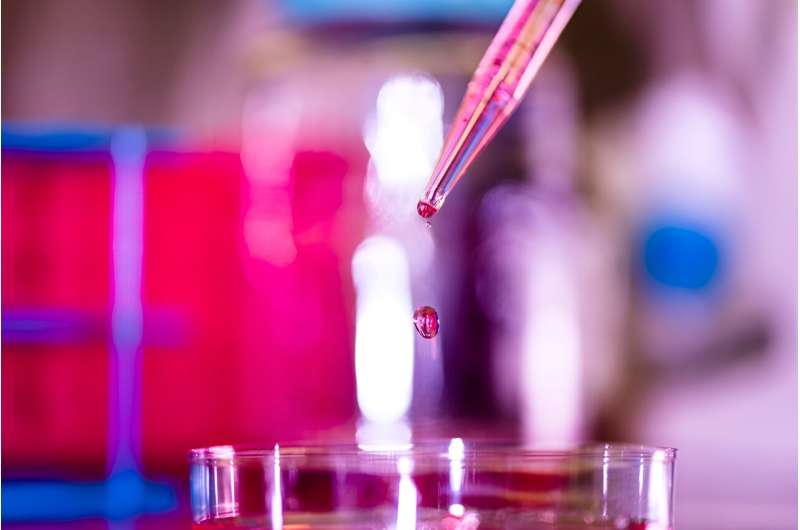This article has been reviewed according to Science X's editorial process and policies. Editors have highlighted the following attributes while ensuring the content's credibility:
fact-checked
trusted source
proofread
How to make mRNA therapeutics safe from the start

The success of mRNA vaccines against COVID-19 has unleashed a flood of interest in using the technology to create more vaccines and treatments for everything from rare diseases and infections to cancer.
But before new mRNA therapeutics are put to use, they need to be assessed for toxicity and patient safety.
A paper published in Nature Reviews Drug Discovery co-authored by Northeastern professor Mansoor Amiji outlines several strategies to check for toxicity at the preclinical level that bypass the need for problematic animal testing.
"We are at a very interesting point in the mRNA field, asking what else can be done with it," says Amiji, university distinguished professor of pharmaceutical sciences and chemical engineering. "Can we develop better therapeutics?"
"We are thinking about ways to make these products safer and identify what types of red flags we should avoid in developing mRNA technology and the use of lipid nanoparticles that deliver the mRNA," Amiji says.
Scientists say what makes mRNA exciting is the way it instructs cells in the body to create proteins involved in potentially treating diseases and preventing infection.
In the case of the COVID-19 vaccines, instead of injecting a weakened or dead virus into the body, the mRNA causes the body to make a piece of the virus in order to create an immune response. The manufacturing time is only a fraction of that involved in developing a traditional vaccine.
Fail early
"Right now there's a huge need in the field to develop better models for testing" new mRNA therapies, Amiji says. He says much of the focus is on "innovative technologies" such as using lab-grown human cells and organs.
Screening early for toxicities is also a matter of cost savings for companies developing new therapeutics, says Amiji. One of his three co-authors, Eric Jaquinet, worked for Moderna.
"In the pharmaceutical industry there is a paradigm to fail early because they want to make sure you're not spending too many resources at the tail end of the study. If you fail in a phase three clinical trial stage, for instance, a huge amount of money—a billion dollars—can be lost," Amiji says.
"Any risk of safety has to be really understood before we start. For therapy, (mRNA) needs to be administered on a chronic basis."
The template for mRNA protein synthesis can lead to loss of some protein function, known as RNA toxicity.
The fatty envelope of lipid nanoparticles that deliver mRNA to cells also is capable of inducing toxicities, the article says.
Some patients are at heightened risk of toxicity
The health risks of toxicity depend to some extent on the health of the patient and how often the mRNA treatment is delivered, Amiji says.
A healthy person who is vaccinated once or twice a year is at lower risk for side effects than a person who is immunocompromised or is dosed repeatedly, maybe for a lifetime, he says.
"If you were a person who was suffering from a disease, a chronic disease, you could be getting treatment every day or every few days."
"You need to ask some very critical questions on safety. Is this product going to be safe on repeat dosing? And how do we make sure we are getting the benefit desired" in terms of consistent protein expression, Amiji says.
Flaws in animal testing
A type of single-stranded RNA that acts as a template for protein synthesis, mRNA delivers instructions to cells that allow them to mount an immune response by producing the protein antigen or produce the missing or non-functional protein that is necessary for disease treatment.
If mRNA is delivered to a target site—say a liver tumor—it's doing its job, Amiji says. "But if that balance shifts off target, you're going to see a huge increase in the risk potential of these types of therapy."
The final steps in preclinical safety testing often include using mouse models and non-human primates.
There are flaws in this approach, as was seen in COVID vaccine trials, when vaccines that were very safe in phase one of the trial showed toxicities when given to a larger population, Amiji says.
"If you test something and the safety margin is high in mice, that doesn't translate well to what happens in humans until you go to non-human primate studies, which are very expensive to do in early stages of drug development cycle," he says.
More information: Dimitrios Bitounis et al, Strategies to reduce the risks of mRNA drug and vaccine toxicity, Nature Reviews Drug Discovery (2024). DOI: 10.1038/s41573-023-00859-3
This story is republished courtesy of Northeastern Global News news.northeastern.edu.




















